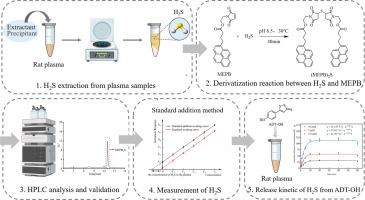高效液相色谱-荧光检测法测定大鼠血浆中硫化氢含量
IF 3.2
引用次数: 0
摘要
硫化氢(H2S)以前被称为臭鸡蛋味的有毒气体,现在是仅次于一氧化碳(CO)和一氧化氮(NO)的第三大气体发射器。精确测定生物体中H2S的水平对于阐明H2S的生物学功能和治疗H2S相关疾病至关重要。本研究以(马来酰亚胺)4-(芘-1-基)丁酸乙酯(MEPB)为衍生试剂,建立了一种灵敏的高效液相色谱-荧光检测(HPLC-FL)检测血浆中H2S浓度的方法。特别是,我们采用标准添加法来排除血浆中复杂内源性物质的潜在干扰。该HPLC-FL方法按照ICH和FDA指南进行了验证,确认了其特异性、线性度、准确性、精密度和稳定性。与传统的UV-Vis法相比,由于样品前处理和衍生化条件不同,该方法具有更高的灵敏度和特异性,能够更准确地检测血浆中H2S。采用HPLC-FL法测定5-(4-羟基苯基)- 3h -1,2-二硫基-3硫酮(ADT-OH)在大鼠血浆中H2S的释放动力学。据我们所知,这是MEPB测定血浆中H2S的首次应用。本文章由计算机程序翻译,如有差异,请以英文原文为准。

A high-performance liquid chromatography with fluorescence detection for measurement of hydrogen sulfide in rat plasma
Hydrogen sulfide (H2S), previously known as a toxic gas with a rotten egg odor, is now the third largest gasotransmitters after carbon monoxide (CO) and nitric oxide (NO). Precisely determining the levels of H2S in organisms is crucial for elucidating the biological functions of H2S and treating H2S-related diseases. This study presents a novel and sensitive high-performance liquid chromatographic method coupled with fluorescence detection (HPLC-FL) for measuring the concentration of H2S in plasma using (maleimide) ethyl 4-(pyren-1-yl) butanoate (MEPB) as a derivatization reagent. In particular, we employed the standard addition method to exclude potential interference from complex endogenous substances in plasma. This HPLC-FL approach was validated in accordance with ICH and FDA guidelines, confirming its specificity, linearity, accuracy, precision and stability. Compared with classical UV-Vis method, this HPLC-FL method provides higher sensitivity and specificity for more accurate detection of H2S in plasma, attributable to the distinct sample pretreatment and derivatization conditions. HPLC-FL method was further utilized in assessing the release kinetics of H2S from 5-(4-hydroxyphenyl)-3H-1,2-dithiole-3thione (ADT-OH) in rat plasma. To our knowledge, this is the first application of MEPB for the determination of H2S in plasma.
求助全文
通过发布文献求助,成功后即可免费获取论文全文。
去求助
来源期刊

Journal of chromatography open
Analytical Chemistry
CiteScore
2.50
自引率
0.00%
发文量
0
审稿时长
50 days
 求助内容:
求助内容: 应助结果提醒方式:
应助结果提醒方式:


